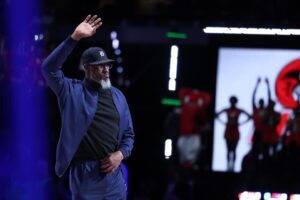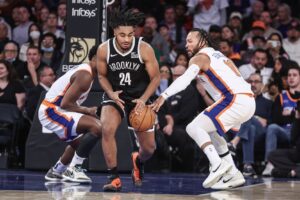When Paul George was traded to the Oklahoma City Thunder, it marked the end of a promising, albeit disappointing era for the Indiana Pacers. The Pacers would deal the disgruntled superstar for a duo of young players. With the benefit of hindsight and years of results to measure, let’s revisit this blockbuster to determine which team came out the winner.
Grading the Paul George to Oklahoma City Trade
The Best of a Bad Scenario
In order to properly judge this transaction, it helps to understand the context around the decision to trade George. Only a few years prior, the Pacers had been to back-to-back Eastern Conference Finals, losing both times to the LeBron James – led Miami Heat. A few poor decisions in the front office led to key players David West and Lance Stephenson leaving the team via free agency despite offers from Indiana to stay. Both George and the Pacers lost nearly an entire season when the star guard broke his leg in a Team USA exhibition. By the time George returned, the Pacers had fallen from the top seed the year before to out of the playoffs completely. After watching such a talented core get dismantled before his eyes, George would answer questions regarding his extension simply. “I want to play for a winner.”
Fearing the possibility of losing their best player with no returns, the Pacers were forced to move on from George. To make matters worse, George’s desire to leave the team was well known throughout the league. This made things exponentially more difficult for Indiana. Why would a big market team like the Los Angeles Lakers make a trade for a player that they could simply sign the following offseason?
An Unlikely Suitor
Enter the Oklahoma City Thunder, another small-market team with a solid core and a superstar point guard. The summer before, the Thunder had watched Kevin Durant leave for the greener pastures of Oakland. Oklahoma City still had Russell Westbrook, a star in his own right, coming off of his second straight all-star appearance (a streak that would end at six). Around Westbrook, the Thunder had an incredibly young core. Of the four players on the roster that averaged double figures in 2016, only Westbrook was above the age of 25. The team finished the year with a 47-35 record but was eliminated in the first round of the playoffs. Oklahoma City felt that they were one player short of a championship-caliber team. The only problem was attracting a key free agent to pair with Westbrook.
The Thunder’s front office believed that they could sell George on re-signing with the team over the course of the year. It seemed like this would be the best chance they would have to add an All-Star to their roster and negotiations began.
The Paul George Trade
In July of 2017, George was traded to the Thunder for Victor Oladipo and Domantas Sabonis. At the time, Indiana was criticized for not landing any draft picks in the deal. However, with what we know now, it is clear that the Pacers received a great haul in return for George. Sabonis was a two-time All-Star in Indiana and averaged a double-double in his time as a starter. Oladipo also made two All-Star teams before suffering a leg injury and ultimately expressing his desire to leave Indiana; a story arc that is eerily similar to George’s.
In Oklahoma, the gamble had paid off as George did opt to re-sign with the team. He was an All-Star in both seasons with the Thunder, helping the team to the playoffs in each campaign. Unfortunately, after back-to-back first-round exits, George would work his magic again, this time orchestrating his way to the LA Clippers to join Kawhi Leonard.
The Grades
When looking at these trades, we will not only take the immediate impact into consideration. Instead, since all three of these players were later traded again, let’s look at the larger picture when providing a grade.
For Indiana, this trade was the best possible outcome. To trade one All-Star for two is an unheard-of feat in the NBA. When considering that George was out regardless, the weight of this win only grows. Oladipo was the first to leave Indiana, being included in the trade that sent James Harden to Houston. The Pacers got Caris LeVert in return, who would eventually be traded to the Cleveland Cavaliers for a first-round pick. Sabonis was a part of another blockbuster before this year’s trade deadline. The smooth big man was sent to Sacramento for Tyrese Haliburton and Buddy Hield. The former is considered by many to be the Pacers’ point guard of the future. With Hield in the trade as well, this could be another example of Indiana making a game-saving trade.
Indiana Pacers Grade: A
Oklahoma City can hardly be considered a loser in this scenario. Not only did the franchise add an MVP-level player to their roster to maximize their potential during Westbrook’s prime, but when George wanted out, the Thunder received a king’s ransom for him. The trade with the Clippers not only brought back Shai Gilgeous-Alexander, but the haul included five first-round picks. It is hard to grade how those picks have played out, as the majority of them are future picks. Nevertheless, it is hard to imagine the Thunder getting a better offer anywhere else. With that being said, two first-round exits from a team led by Westbrook and George should be considered a disappointment.
Oklahoma City Thunder Grade: B (Could be an A by 2025)
Main Photo
Embed from Getty Images






